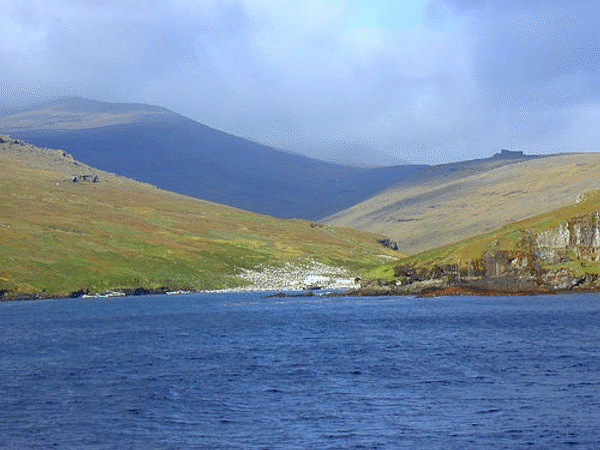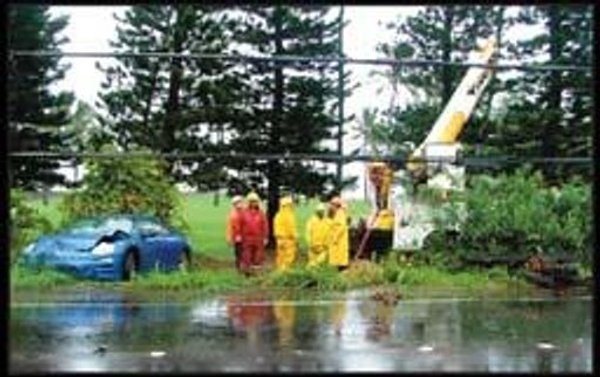A writer for the SmarterTravel.com website emailed me asking for info about hiking the Kalalau trail. While I’m a bit put off by their attitude that hiking is just a cheap way to see Hawaii (“[the hikes] were as amazing as they were inexpensive“), I’m always glad to give out hiking information on this blog. Hopefully they will see the appeal of hiking to their readers and change their attitude–after all, hiking (and walking around) is the only way to see the real Hawaii.
Update 1: I forgot to give the “official website” for the Kalalau trail from Hawaii State Parks.
Update 2: The SmarterTravel.com website does have a more eco-friendly page that lists several hiking and kayaking resources.
Update 3: Several people have asked for more details about the trail, and I have responded at length in the comment section, so be sure to read all the comments.
Update 4: The article about Kalalau has just been published on SmarterTravel.com. It says “Hiking is the best way to get to the heart of Kauai, both in geography and spirit,” and I couldn’t agree more.
Update 5: camping restrictions have changed, and single-night stop-over permits are now given for Hanakoa instead of Hanakapiai–see below.
Q: What is the best time of year to do this hike?
A: Usually in the late spring, (May and early June), after the rains mostly stop but before the ocean is calm enough to allow kayaking. During late-June and July, the weather is driest, but Kalalau is “crowded” with kayakers who overtake the beach and campground. August is still crowded and much more humid, making the hiking very uncomfortable. The rest of the year is hit-or-miss, with perfect weather separated by rainy periods.

View of Kalalau Beach and the cliffs above as you arrive
Q: Do most fit hikers planning to do the full 22 mile out and back hike take two days, camping one night at Kalalau Beach ?
A: No, I think that is unrealistic. Only extremely fit people can go in and out in 2 days and still enjoy themselves (but they won’t enjoy Kalalau). I know a tourist on a 2-day schedule who had to camp in the dark on the trail, and the next day sprinted to the top of the descent into Kalalau, saw the view, and turned around to hike out. Don’t let this happen to you. My ideal “short” schedule is 4 and a half days:
- Start in the afternoon and camp the first night at Hanakapiai.
- Start hiking around dawn and reach Kalalau by early afternoon.
- Stay 3 nights in Kalalau, giving you time to relax and explore.
- Get up before dawn again and hike all the way out in one day.
Q: Are there designated camping spots at Kalalau Beach ?
A: There is a designated camping area right next to the beach with fairly clear tent sites. Some tent sites overlooking the beach or waterfall are idyllic, but they are all available first-come, first served. There are many more campsites in the forest, 50-100 yards from the beach. There are a few secret spots too.
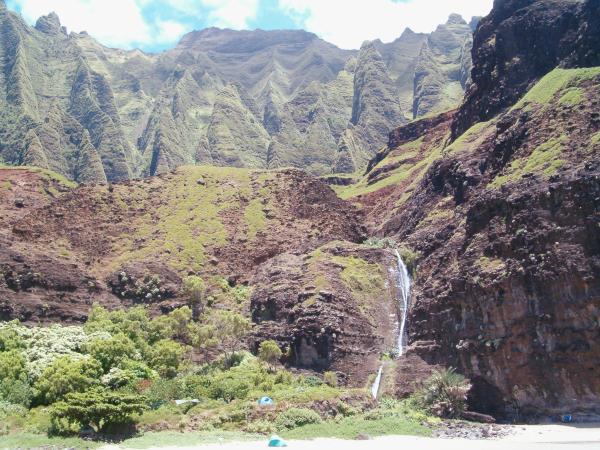
Nakeikionaiwi cliffs and Hoolea waterfall above the camping area
Q: How many camping areas are there along the trail (I heard the one at Hanankapi’ai is closed)?
A: There used to be permitted camping at Hanakapiai and Hanakoa. I’m fairly sure Hanakoa is closed indefinitely, and you wouldn’t want to camp there anyways because of the trash, pigs, mud and mosquitoes. I have not heard that Hanakapiai is closed, but it is very possible. They have to close the campsites if the composting toilet is out of order, and that happens often with vandalism/retaliation. Again, there are some secret spots too, obviously non-permitted.
Update July 2007: camping restrictions have changed, and permits are now given for Hanakoa instead of Hanakapiai. I had previously heard camping was restricted at Hanakoa to preserve the archeological sites (rock walls and terraces), but Hanakapiai was becoming so overused that the park managers decided its sites were now more at risk. Hanakoa is the more logical half-way point to camp, and people were camping there anyways, but I still find it to be too muddy, muggy, and buggy.
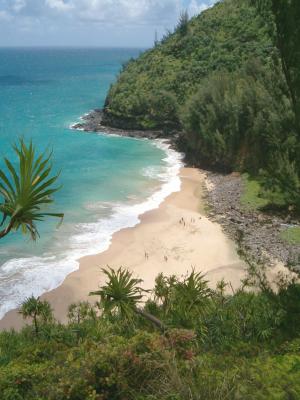
Hanakapiai Beach from the south |
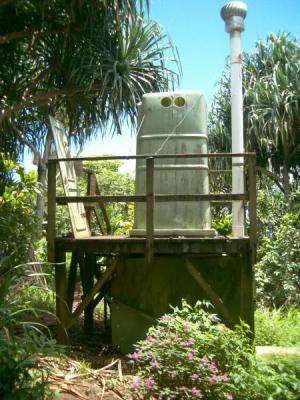
Composting toilet in disrepair at Hanakapiai |
Q: Can you briefly describe the physical landscape you’ll experience on this trail?
A: The trail skirts the NW and W facing cliffs and valleys between the wet north shore and drier west-side of Kauai. The 11 mile (18km) trail was established by the Hawaiians centuries ago and follows ledges on the cliffs and dips down into 5 major valleys (including Kalalau) and numerous little gullies.
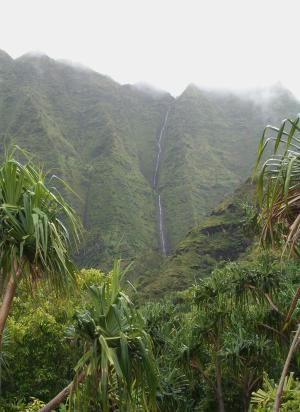
Lush and misty Waiahakua Valley |
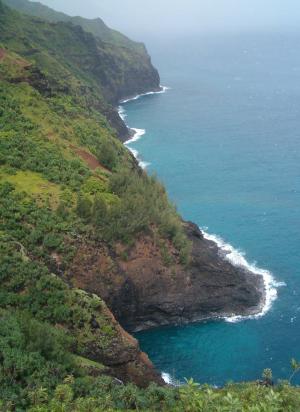
Na Pali coast south of Hoolulu Valley |
The ledges are usually plenty wide and vegetated, offering views up and down the coast as well as cooling sea breezes. During winter and early spring, it is common to spot whales in the ocean. The valleys are lush and humid, offering views of waterfalls and green mountains. You can often find edible fruit such as wild guava, lilikoi (passion fruit) and mountain apples (a tropical fruit not related to apples). The large valleys involve stream crossings, and most gullies have water for drinking after treatment. Near the end, you reach a crest, turn a corner and Kalalau Valley opens up before you, with near-vertical walls curving inland and around to the beach on the opposite side.
Q: What would you say are the highlights of a Kalalau hike?
A: If you mean highlights of the trail, it would be the views up and down the Na Pali coast (the cliffs) , the view 700 feet straight down from Space Rock, the views into some of the valleys including Kalalau itself, and the exhilaration of going down the last slope to the golden beach and waterfall.
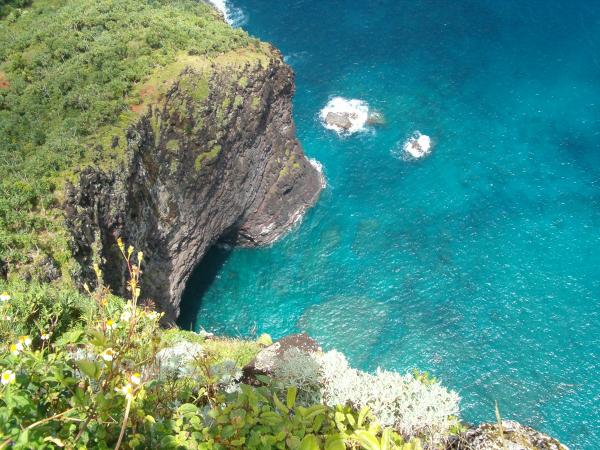
Looking straight down from Space Rock (the Gate as I prefer to call it)
If you mean highlights of the whole trip, it’s definitely being on a remote beach, surrounded by incredible beauty, exploring a semi-deserted valley, feeling like a hippie and skinny-dipping (technically illegal as well), and of course, the views. Beyond the phyiscal impression, there is a certain sacred awe at being in such a magnificent natural setting. I sometimes call it a Hawaiian cathedral, not just because of the towering cliffs on all sides, but because Kalalau epitomizes the natural balance between the Hawaiian culture and the physical world.
Q: What fitness level and safety precautions would you recommend?
A: I would recommend the Kalalau trail only to very fit and experienced backpackers, which I consider the ability to pack 40+ lbs 15 miles and 3000 feet uphill on the mainland. Note that the elevation gain for the Kalalau hike has been quoted anywhere from 2000 to 5000 feet each way, but I actually think it’s somewhere between 2200 and 2600. Regardless, the heat and humidity make it seem like much more.
You will need the usual equipment: hiking boots, hat, sunscreen, water treatment, etc. An internal frame pack is better because it won’t get caught on low branches and rocks. You should have a screened tent against the mosquitoes and a rain fly against the inevitable shower. You don’t need a sleeping bag, a fleece blanket or bedroll is enough. Hiking poles are useful for crossing streams and balancing heavy packs, but can be an inconvenience in the overgrown sections.
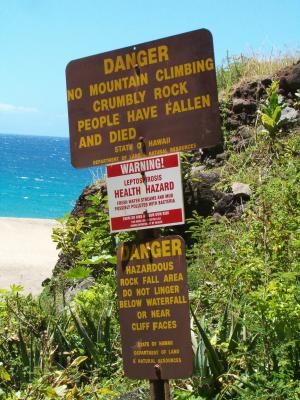
Warning signs from the state at Hoolea falls |
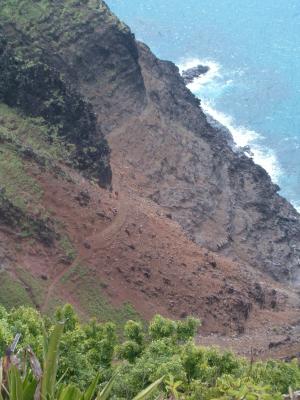
Scariest part of the trail |
Safety Precautions:
The trail itself can be treacherous. One cliff-face around 7 miles has a very steep and impressive dropoff, one eroded section at 8 miles requires careful footing, and in some places the overgrown vegetation pushes you off the narrow trail or hides a dropoff.
Only the first valley of Hanakapiai has a sandy beach in the summer, but swimming there is NEVER recommended. Swimming at Kalalau beach is possible but dangerous due to strong waves and rip currents. As the safety slogan says: “When in doubt, don’t go out.”
Some people pitch tents or sleep directly on the beach in the summer. While technically illegal if you’re not actively shore-casting, it is also very dangerous if the beach is not wide enough to stop the occasional rogue wave.
All water from streams and waterfalls must be treated due to the Leptospirosis hazard. Boiling for several minitues is still the most effective; the bacteria can theoretically go through a 1 micron filter, so you should add cholrine drops to filtered water.
Heavy rains are possible any time of year, making the trail muddy and slippery, making streams impassible, and sometimes causing erosion that physically cuts the trail. Never cross a flooded stream, people have been swept downstream and over waterfalls to their death. When the trail is impassible due to severe weather, you will be stuck overnight or longer in Kalalau or one of the wetter valleys. State agencies will perform helicopter evacuations after several days only if the trail is predicted to remain impassible.
Q: Any other comments you’d like to share?
A: Kalalau is definitely a world-class hiking trail, though you wouldn’t know it from the way local agencies fail to maintain it. However, they still collect fees and enforce permits. There are permit quotas year-round, and the best summer weeks must sometimes be reserved a year ahead of time. For permit information and availabililty, call the State Parks at 808-274-3444 (8am-12 and 1-4pm locally). Recently, due to a crackdown on illegal camping, mostly by hippies who live off and on in the valley, rangers have been helicoptered in to check all permits. So do not assume you can get by without a permit because it is so remote. Finally, if you go, please preserve and protect the area as much as you can, avoiding erosion and keeping it clean for future hikers and future generations.
If you’ve read this far, I’ll share another tip with you: if you’re looking for specific trail information, you can email me, Andy {AT} great-hikes.com, and I’ll try to answer your questions here. I originally wanted to give full hike descriptions for all our trails, so you wouldn’t have any questions left to ask, but I haven’t had time for writing that much. If I know people want and need the information, I’m more likely to write about it.
